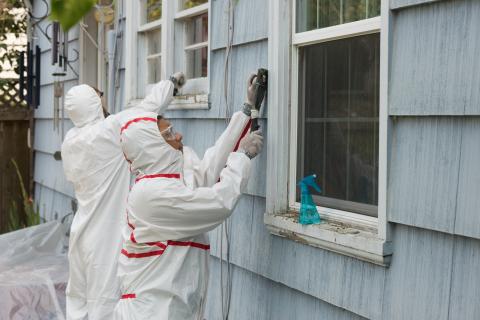Lead-Safe Wisconsin: The Lead-Safe Homes Program
Funding opportunity: Help Make Children's Homes Lead Safe
Grant period October 1, 2025, through September 30, 2026
Background
The Lead-Safe Homes Program (LSHP) has grant opportunities available to make children homes lead safe beginning on October 1, 2025, and ending September 30, 2026. Childhood lead poisoning impacts every county in Wisconsin and LSHP is asking for your assistance in making children’s homes safe from lead-based paint hazards.
Funding details
Funding is available statewide and is separated into four grant types with unique activities. Each grant type requires its own application. Applicants may apply to one of these grants or up to four. Each grant name below is linked to the Wisconsin Public Notice website with full details and application materials.
- Program Administrative Grantee
- Lead Investigation Grantee
- Lead Hazard Reduction Grantee
- Lead Laboratory Analytical Grantee
The application deadline is May 12, 2025, at 11:59 p.m.
LSHP has staff dedicated to help you along the way. Contact LSHP at DHSLeadSafe@dhs.wisconsin.gov for more information.
General program information for property owners and occupants
If you live in a home built before 1978 that has chipping or peeling paint, the Wisconsin Lead-Safe Homes Program (LSHP) may be able to help. This program makes homes safe for kids or pregnant women that are on Medicaid or BadgerCare Plus in Wisconsin by removing lead hazards.
The Wisconsin Department of Health Services (DHS) runs the LSHP in partnership with local and regional community groups that receive grants. To learn more, call 608-267-9191 or email DHSLeadSafe@dhs.wisconsin.gov.
LSHP prioritizes applications and projects based on the criteria below. Please note that applications may be placed on hold due to the high interest in LSHP and the service areas of LSHP grantees. This determination will be made after a complete application is reviewed for eligibility.
- Priority 1: Homes where a child has been identified with an elevated blood lead level, as defined by Wis. Stat. § 254.11(5m), and the local health department has issued orders for correction
- Priority 2: Homes of children that are poisoned, as defined by Wis. Stat. § 254.11(9), but are not subject to lead hazard reduction work orders from the local health department
- Priority 3: Homes built before 1950 that do not have a lead-poisoned child, as defined by Wis. Stat. § 254.11(9), or lead hazard reduction work orders
- Priority 4: Any other eligible property
You must meet all of the requirements below:
- Your home was built before 1978.
- Your taxes are paid to date or you are enrolled in a tax payment plan.
- Children under age 19 or a pregnant woman living at or regularly visiting your home are on, or are eligible for, Medicaid or BadgerCare Plus. ("Regularly visiting" means visiting for at least three hours per day on two or more days per week, totaling at least 60 hours per year.)
If you’d like more information, download our Lead-Safe Homes Program: Making Homes Lead-Safe for Kids brochure, P-03292 (PDF)
How does the program help?
The LSHP helps:
- Children grow up in homes that are lead-safe.
- Property owners pay for needed fixes to make homes lead-safe.
- Contractors get trained and certified in lead-safe work practices.
- Communities improve older housing stock.
When a property is approved, what costs are covered by the LSHP?
The LSHP will cover these costs for approved properties:
- Property assessments, before and after repair work is completed
- Lead-safe repairs of identified lead-based paint hazards, such as replacing windows, doors, and paint (Note that this is not a home makeover or remodeling program like on television.)
Why should I participate in the program?
- Owner-occupant homeowners: The program covers 100% of the costs to make your home lead-safe.
- Landlords: Beginning October 1, 2023, the program covers 90% of the costs to make your rental properties lead-safe.
- Renters: There is no cost to you.
*Due to the significant interest in this statewide program and every home being unique, LSHP cannot provide you with a specific time frame for each step of the LSHP process. Also, please be aware that your application may be put on hold and that it may take 12 months or more to start the work on your home, if eligible.
What forms do I need to submit?
The forms you must submit depend on whether the owner lives at the property ("owner-occupied") or does not live at the property ("rental"). Find the required forms for your property type below. Note: Applications without a completed Occupant Worksheet will not be processed.
Owner-occupied properties
The owner-occupant must submit two forms:
- Owner-Occupied Properties - Lead-Safe Homes Program Application, F-02610 (PDF) – Owner-Occupied Properties application, F-02610s, in Spanish (PDF), and
- Occupant Worksheet - Lead-Safe Homes Program Application, F-02610B (PDF) – Occupant Worksheet, F-02610B in Spanish (PDF)
Note: If you own a multi-family home and occupy one of the units, you must submit the Owner-Occupied Properties Application and Occupant Worksheet for your own unit.
The following forms must be submitted for the other units:
- Rental Property Application. F-02610a (PDF) – Rental Property Application, F-02610a in Spanish (PDF) and
- Occupant Worksheet, F-02610b (PDF) – Occupant Worksheet, F-02610b in Spanish (PDF).
Rental properties
- The landlord must submit Rental Property - Lead-Safe Homes Program Application, F-02610A (PDF) – Rental Property, F-02610AS in Spanish (PDF)
- The tenant(s) must submit Occupant Worksheet - Lead-Safe Homes Program Application, F-02610B (PDF) – Occupant Worksheet, F-02610BS in Spanish (PDF)
How do I submit completed forms?
Follow the submission instructions found at the top of each form.
Call 608-267-9191 or email DHSLeadSafe@dhs.wisconsin.gov to contact the LSHP team.


